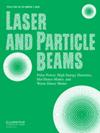Oscillating Plasmas for Proton- Boron Fusion in Miniature Vacuum Discharge
IF 1.9
4区 物理与天体物理
Q4 PHYSICS, APPLIED
引用次数: 2
Abstract
Earlier, the experiments on the aneutronic proton-boron (pB) fusion in a miniature nanosecond vacuum discharge (NVD) with oscillatory plasma confinement and correspondent α particles yield were presented. In this work, we consider some specific features of oscillatory confinement as a relatively new type of plasma confinement for fusion. Particle-in-cell (PiC) simulations of pB fusion processes have shown that the plasma in NVD, and especially on the discharge axis, is in a state close to a quasineutral one, which is rather different from the conditions in the well-known scheme of periodically oscillating plasma spheres (POPSs) suggested earlier for fusion. Apparently, small-scale oscillations in NVD are a mechanism of resonant ion heating, unlike coherent compressions in the original POPS scheme. Nevertheless, the favorable scaling of the fusion power in NVD turns out to be close to the POPS fusion but differs significantly both in the compression ratio and in the values of the parameter of quasineutrality. In addition, unlike the POPS scheme, PiC simulation reveals that the distribution functions of protons and boron ions in NVD are non-Maxwellian. Therefore, we have an aneutronic pB synthesis in a nonequilibrium plasma remaining “nonignited” on the discharge axis.微型真空放电中质子-硼聚变的振荡等离子体
在此之前,我们进行了微纳秒真空放电(NVD)条件下无中子质子与硼(pB)的聚变实验,并研究了振荡等离子体约束和相应的α粒子产率。在这项工作中,我们考虑了振荡约束作为一种相对较新的等离子体核聚变约束的一些特定特征。粒子池(PiC)对pB聚变过程的模拟表明,NVD中的等离子体,特别是在放电轴上,处于接近准中性的状态,这与之前提出的众所周知的周期振荡等离子体球(POPSs)聚变方案中的条件有很大不同。显然,NVD中的小尺度振荡是一种共振离子加热机制,不同于原始POPS方案中的相干压缩。然而,NVD中聚变功率的有利尺度接近于POPS融合,但在压缩比和准中性参数值上存在显著差异。此外,与POPS方案不同,PiC模拟显示NVD中质子和硼离子的分布函数是非麦克斯韦式的。因此,我们在放电轴上保持“未点燃”的非平衡等离子体中进行了无中子pB合成。
本文章由计算机程序翻译,如有差异,请以英文原文为准。
求助全文
约1分钟内获得全文
求助全文
来源期刊

Laser and Particle Beams
PHYSICS, APPLIED-
CiteScore
1.90
自引率
11.10%
发文量
25
审稿时长
1 months
期刊介绍:
Laser and Particle Beams is an international journal which deals with basic physics issues of intense laser and particle beams, and the interaction of these beams with matter. Research on pulse power technology associated with beam generation is also of strong interest. Subjects covered include the physics of high energy densities; non-LTE phenomena; hot dense matter and related atomic, plasma and hydrodynamic physics and astrophysics; intense sources of coherent radiation; high current particle accelerators; beam-wave interaction; and pulsed power technology.
 求助内容:
求助内容: 应助结果提醒方式:
应助结果提醒方式:


